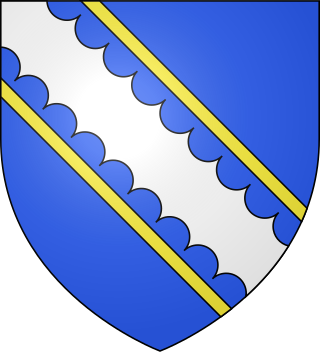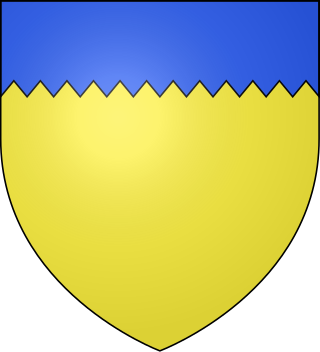
Baron Saye and Sele is a title in the Peerage of England held by the Twisleton-Wykeham-Fiennes family. The title dates to 1447 but it was recreated in 1603. Confusion over the details of the 15th-century title has led to conflicting order for titleholders; authorities such as Burke's Peerage and Debrett's Peerage do not agree on whether or not the 1447 creation is still extant.

Earl of Mornington is a title in the Peerage of Ireland. It was created in 1760 for the Anglo-Irish politician and composer Garret Wellesley, 2nd Baron Mornington. On the death of the fifth earl in 1863, it passed to the Duke of Wellington; since that date, the title has generally been used by courtesy for the heir apparent to the heir apparent to the dukedom.

Baron Kingsale is a title of the premier baron in the Peerage of Ireland. The feudal barony dates to at least the thirteenth century. The first peerage creation was by writ.

Viscount Clermont, of Clermont in the County of Louth, was a title in the Peerage of Ireland. It was created in 1776 for William Fortescue, 1st Baron Clermont, with special remainder in default of male issue of his own to his brother James Fortescue and the heirs male of his body.
Bermingham is a surname, and may refer to:
Rickard de Bermingham, otherwise Rickard Mac Fheorais, was Anglo-Irish lord of Athenry.

The de Birmingham family held the lordship of the manor of Birmingham in England for four hundred years and managed its growth from a small village into a thriving market town. They also assisted in the invasion of Ireland and were rewarded with the Barony of Athenry. They were stripped of most of their lands in England by the notorious John Dudley, Duke of Northumberland, who held sway over the young King Edward VI (1547–1553).

Bermingham is the Gaelicised version of 'De Birmingham' and is descended from the family of Warwickshire, England. The Irish version of the name Mac Feorais/Mac Fheorais is derived from Pierce de Bermingham. The first recorded Bermingham in Ireland, Robert de Bermingham accompanied Richard de Clare or 'Strongbow' in Henry II's conquest of Ireland in 1172. On arrival he received: "an ancient monument, valued at 200 pounds, on which was represented in brass the landing of the first ancestor of the family of Birmingham in Ireland."
John de Bermingham, 1st and last Earl of Louth was an Irish peer. He was the commander of the Anglo-Irish army in the Battle of Faughart, the decisive battle in the Irish Bruce Wars 1315–1318. In this battle, Edward Bruce was killed, and Bermingham had Bruce's severed head 'salted in a chest' and transported to England to be put on display before Edward II. He was briefly Viceroy of Ireland in 1321.
Meyler de Bermingham was an Anglo-Irish lord, founder of Athenry.
Edmond de Bermingham was an Anglo-Irish lord, alive in 1645.
Thomas Bermingham, 1st Earl of Louth was an Anglo-Irish politician and peer. He was also the last man to be summoned to parliament as Baron Athenry.

Francis de Bermingham, 14th Baron Athenry, was an Anglo-Irish peer.
Richard II de Bermingham was an Anglo-Irish lord.
Edmond I de Bermingham, Anglo-Irish lord, born c. 1570, died 1645.

Butler is the name of a noble family whose members were, for several centuries, prominent in the administration of the Lordship of Ireland and the Kingdom of Ireland. They rose to their highest prominence as Dukes of Ormonde. The family has produced multiple titles such as Baron Cahir, Baron Dunboyne, Viscount Ikerrin, Viscount Galmoye, Viscount Mountgarret, Viscount Thurles, Earl of Carrick, Earl of Kilkenny, Earl of Ormond, Earl of Ossory, Marquess of Ormonde and Duke of Ormonde. Variant spellings of the name include le Boteler and le Botiller. The Butlers were descendants of Anglo-Norman lords who participated in the Norman invasion of Ireland in the 12th century. The surname has its origins in the hereditary office of "Butler (cup-bearer) of Ireland", originating with Theobald Walter, 1st Chief Butler of Ireland. The arms of later family members depicted three cups in recognition of their original office.

Richard Óg de Burgh, 2nd Earl of Ulster and 3rd Baron of Connaught, called The Red Earl, was one of the most powerful Irish nobles of the late 13th and early 14th centuries and father of Elizabeth, wife of King Robert the Bruce of Scotland.
There are numerous Bermingham monuments in Ireland, particularly in counties Kildare, Offaly, Galway, and Dublin. Most are now in a poor state but Athenry Castle in Galway has been restored, using building techniques similar to those employed when it was originally built.
John Bermyngham or Bermingham was an Irish barrister and judge. He was one of the first Crown Law officers to be referred to as the King's Serjeant. He was later appointed Lord Chief Justice of Ireland, but did not take up the office.
Thomas Bermingham may refer to:









